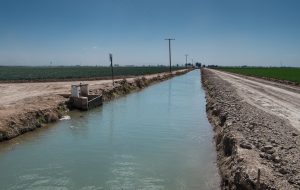There’s something that really jumps out in the Bureau of Reclamation’s final accounting of 2016 Lower Colorado River Basin water use.
In May, the Bureau releases the official accounting, which is a meticulous, tedious, closely watched and monitored and argued over report on who used how much water on the Lower Colorado. Much to digest in the report, and I haven’t ground through the full details yet, but this caught my eye.
The Imperial Irrigation District, the largest water user on the Colorado River, saved 513,573 acre feet in 2016 through a variety of conservation programs. That is more than two Las Vegas’s consumptive use. That is more than ten Albuquerques.

Crops and a canal, Imperial Valley, March 2014, by John Fleck
Some of this involves longstanding conservation efforts done in collaboration with other California water agencies, some is more recent. Some involves fallowing fields to conserve water, some system efficiencies, some canal lining. Here’s the tally, from a presentation last week to the IID board by district water manager Tina Shields:
- IIM/MWD system efficiency agreement: 105,000 af
- All-American Canal Lining: 67,700 af
- Fallowing: 152,641 af
- Main canal seepage interception: 35,393 af
- Interties between canals, allowing more efficient water movement: 3,603 af
- 12-hour deliveries (amazing the water saved by delivering water in more precisely timed blocks!) 11,651 af
- on-farm efficiency 138,585 af
That adds up to a 20 percent decrease in water consumption since 2003 on the part of the largest user on the Colorado River. That’s a lot of water. We don’t have the 2016 ag production numbers yet, but in general what we’ve seen during that period is an increasing trend in agricultural productivity. In 2015, inflation-adjusted farm income was up 26 percent from 2003. As I wrote in my book, as water becomes more scarce, farmers have been shifting land out of low-dollar crops like alfalfa and into high-dollar crops like lettuce and other vegetables.
Less water, more agricultural productivity. Important lessons here.

Good stuff as always John. Will be interesting to see if this trend continues and if or how other similar mostly ag delivery organizations do the same. It is a positive in the usual “sky is falling” story on ag water use.
Brian –
The timing’s a little different, but the story is similar for Arizona’s on-river ag – the Colorado River Indian Tribes and the folks in the Yuma area. They peaked in the early 1980s, and current use is ~25 percent below that. That means that essentially all the big desert agriculture on that section of the Colorado is using less than it used to.
Hi John — are those farm income numbers specifically for PVID, or generally for the state / region?
The farm production numbers are for Imperial County (this is Imperial we’re talking about here, not PVID). Imperial County ag production numbers are almost entirely Imperial Irrigation District – small fraction down in Bard, but doesn’t change the overall trend.
Hi John,
I’m not sure whether you’re still checking this post for comments, but here goes.
In the following phrase, are you referring to Imperial County? If not, what region?
“…in general what we’ve seen during that period is an increasing trend in agricultural productivity.”
And how are you defining “productivity”? (Based on the subsequent sentences you seem to be talking about income increasing, not agricultural productivity increasing; but perhaps I’m misunderstanding you.)
Thanks — cheers.
Jenny –
Good question, thanks. In this case I’m referring to Imperial County (which is IID plus Bard, but Bard’s tiny). But it also applies to Yuma County across the river. I’m measuring productivity by inflation-adjusted agricultural sales. Production of the vegetable crops has gone up in both volume and dollar terms – lettuce, onions, carrots, etc. The reduction in water use has come from a reduction in acreage for the lower-dollar-value feed crops, mostly alfalfa, so both money and volume have dropped. Cattle production has been pretty stable.
Similar pattern in Yuma, though the time frame is different – the trend away from low-dollar alfalfa and cotton and toward vegetables, especially lettuce, began earlier.